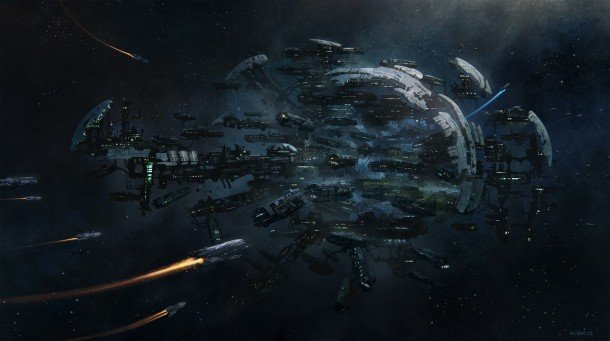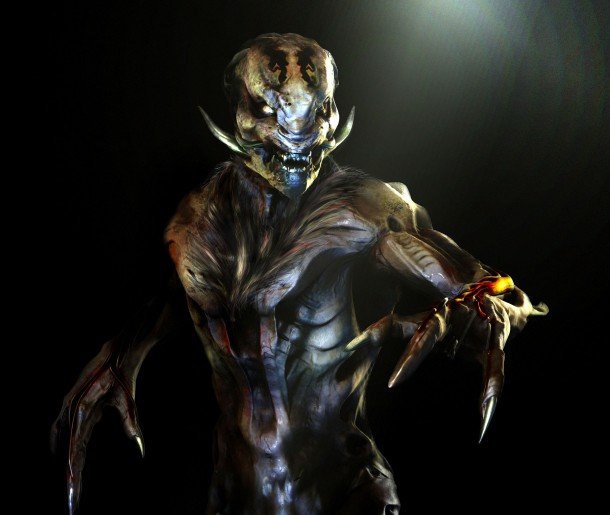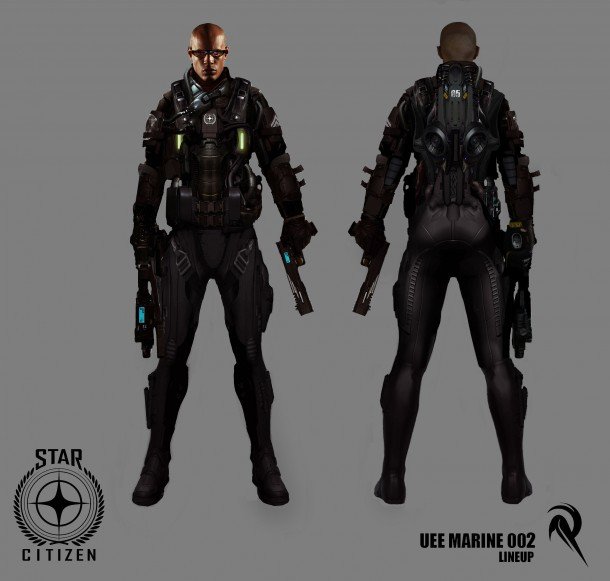Star Citizen interview with Chris Roberts - new concept art and in-engine screenshots
PC Gamer: Is the idea of being an information courier something we'd see in scripted missions, or is there information in the simulation other players might actually need and pay for?
Chris Roberts: So, the system—and we will do an update on this in the future, because we've also done a lot of work on how the economy system works—but the way that we're running everything is that we're going to simulate the universe with AI. So my goal with the game is: you should play it, and it doesn't matter if there's one concurrent user or a million concurrent users, it's alive and active. So basically, AI is going about their business, trading, being pirates, fighting, building units, creating purchase orders for equipment which generates a mission for trading.
So when players get in, they push out an AI role. So, they can take that place, but it also depends on you as a player. If I'm flying a ship and I don't really like PvP and I don't want to do that, I can say “I don't like that,” and the game will put AI in your shared space versus other players. But if someone says “I'm fine with PvP,” if there's a player around he will pop in instead of an AI pirate.

But the whole idea on the information stuff is that we have a whole economy system that's node based... One node might be creating a missile—say it's an armaments factory—and that would have multiple nodes in it for each one of the weapons. One of those nodes might be for a missile, and that missile might require grade-three electronics, and this kind of material, for explosives or whatever, and essentially that node needs to get those units in that ratio. Plus, you need to have population—crew, employees, or whatever—of a certain amount. Plus you have to have the equipment. And if it's got all of those things then you can produce one missile, or whatever it may be.
So that node—that factory—would say, “I need grade-three electronics and things, and I've got so many employees, and I've got so much storage, so I can make five missiles a turn.” So it will put out orders and say “I need this, this, and this,” and those orders will go onto the mission boards and players can take those, and if there aren't players an AI will take that mission and do it.
"It doesn't matter if there's one concurrent user or a million concurrent users, it's alive and active."
So that's an example of the economy generating missions. So they come in and then the missiles are done. And as missions are happening around that system, if there's combat going on, either players are buying missiles or AI will be buying inventory, because they'll fly their mission. We don't simulate the AI stuff if you aren't actually seeing it, but we resolve it. So, “OK, you flew your mission and there's a 50 percent change you got jumped by a pirate, and if you got jumped by a pirate you would've expended one to three missiles.” So that AI character would go, “OK, I need to buy more missiles.” And he'd go to the factory to buy more missiles.
So there is limited supply and demand. If you go to the factory and the AI has bought all the missiles, there are no more missiles for purchase that turn. Now, of course, if nobody's buying any missiles, there's a big inventory. First of all, the price of missiles would go down, but then also that factory is going to be running at a loss, and so maybe it starts to lay off some of its people. It lays off some of the people on the planet, so the happiness level of the people on the planet goes down. And you've got to keep the people on the planet happy, if you're running a factory. So there's all these dynamics and all these things generating missions.
Keep up to date with the most important stories and the best deals, as picked by the PC Gamer team.

"I'm trying to illustrate a system that's very procedural."
On the information stuff, there is information that transfers, like “OK, we need this class three electronics.” You send out these purchase orders and those propagate out, because in this universe there's no faster-than-light communication. So what happens is, there's relays—everything's inside the system at the speed of light, essentially beaming a radio wave—and if you're in the central hub where there's communication relays at each jump point, they send a drone across each 30 minutes or whatever it was, with the data packets they've received. Then it goes to the other star system and gets beamed down. And that's the case where a data courier would be involved in a more remote system, because they don't have the data relays.
And that information is valuable. So knowing that there's a shortage or surplus in a certain area, a data courier could get that information out in a more remote area. So the idea is to design this mission generation system that is for both players and AI, that is generated from this economy system, plus the players themselves can generate them. Because if you're doing well at your missile factory and loads of people are buying missiles and you're always out of stock, you're like, “OK, I better upgrade my missile factory, so I need to buy another missile making machine.” So you purchase the missile making machine, and then you have to make sure you have enough employees to run the missile making machine, and they've got to be fed and happy. And that's how the population would grow on a planet.
I'm trying to illustrate a system that's very procedural, that will also be creating the missions in the world. Scripted stuff we do is sort of on top, more for color and character, but most of the stuff will be happening in the system I'm describing.

How much of this has been implemented since the prototype?
Well, as far as project progress, our Austin studio is fully staffed up. I'm really happy with the team—all our project leads are on. The LA office will be finished second week of April, so all the people in LA working at home will have a home to work in.
We integrated to the most recent version of CryEngine, which is sort of Crysis 3 and above. That was a pretty big integration, plus getting everyone up to speed, and getting our pipeline and workflow working properly. So, our model is, we have sort of the high-end lead or hero artists that say, “This is how the high-end hero ship's going to be, or this is how the high-end characters will be.”
"We've had 20 different ships going, people flying around in our office."
So we're finishing up the process of that, getting it into the engine, getting everyone happy with the tools and the workflow. So I think in the next couple months—what I'm wanting to do is get back to showing gameplay video. On the actual code implementation—the dogfighting stuff—we've had 20 different ships going, people flying around in our office. We have the ship system I talked about in the game. It doesn't have all the visual HUD stuff working yet, which is a thing we're working on right now, where all what's going on is reflected in the display and you can see it, tweak it, and control it more. That's the stage we're in right now, and we've got some really cool stuff like shield effects that are pretty radical. Those really high-end tessellation, wave ripple, and you can see energy dissipate.

So I feel like we're progressing at well toward the dogfighting alpha that we want to have at the end of the year, and we're also progressing pretty well toward the hangar module, which is the one where you can walk around in-engine, which we're planning to release in August at Gamescom and PAX Prime. You'll be able to see the ships you've backed and get inside of them, invite some friends to your hangar. There should be some level of customization at that point, where you can do some stuff to make your ship look cool, or be more unique, or even change out some of the equipment on it.
Thank you to Chris Roberts for taking the time to talk with us. We'll have more on Star Citizen in the near future—for now, you can find more information in our preview , which was posted after the announcement last October, and on the official site .

Tyler grew up in Silicon Valley during the '80s and '90s, playing games like Zork and Arkanoid on early PCs. He was later captivated by Myst, SimCity, Civilization, Command & Conquer, all the shooters they call "boomer shooters" now, and PS1 classic Bushido Blade (that's right: he had Bleem!). Tyler joined PC Gamer in 2011, and today he's focused on the site's news coverage. His hobbies include amateur boxing and adding to his 1,200-plus hours in Rocket League.

